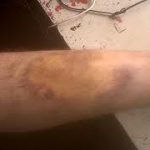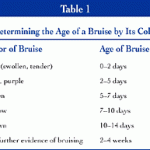Determining The Age Of Bruises
On occasion, you may encounter a patient who has bruising and wonder how old the injuries are. Or there may be several bruises and you would like to know if they occurred at different times. This becomes especially important when dealing with injured children in whom there is a suspicion of abuse.
Bruising occurs when blood leaks from blood vessels into the skin and subcutaneous tissues. If the skin and soft tissues are firm, bruising is not as apparent. In areas where the skin and soft tissues are loose, such as the peri-orbital areas and scrotum, bruising is visible early and may be extensive. The elderly tend to bruise easily because both the skin and subcutaneous tissue are very thin and friable.
A predictable series of color changes occurs with most bruises. During the acute phase, the color is usually reddish and the area may be raised and tender. After about 2 days, the color turns purple and any swelling usually disappears. Over the next week, the color changes to green and yellow as the heme metabolizes. Finally, the color fades and by two weeks most evidence of the injury is gone.
The table above is a key to estimating bruise age. However, this is not an exact science! A number of studies have been performed showing that examiners given photographs of bruises of various ages were not terribly accurate. Fresh and intermediate bruises were identified fairly accurately, but not so for older bruises.
The trauma professional may find it helpful to use these guidelines when trying to decide if there are both fresh and older bruises present. This may indicate that an older adult may be suffering from frequent falls, or that a child needs to be evaluated for abuse.
Reference: Estimation of the age of bruising. Arch Dis Childhood 74:53-55, 1996.


